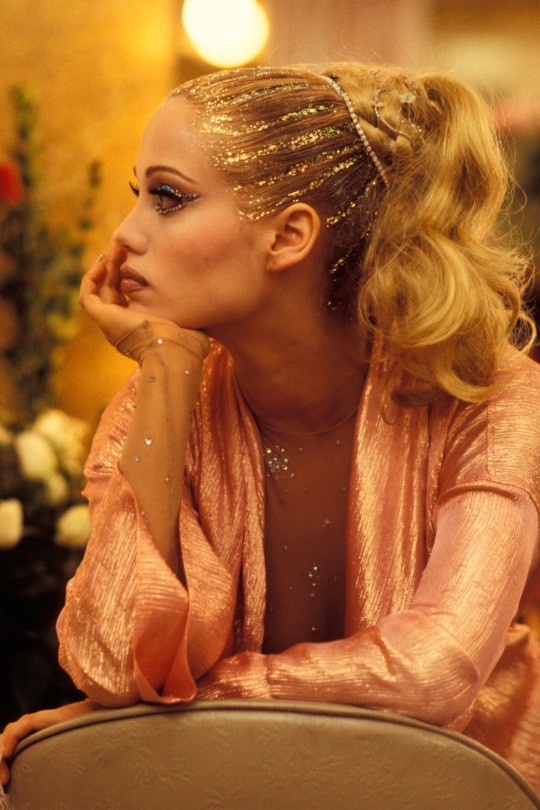Exploring why the 1995 film Showgirls is an enduring cult classic.
(Due to the film's copious amount of salty language and nudity, these posts are probably NSFW)
Next year will mark the twenty-fifth anniversary of one of the most memorable films of not just the 1990s, but if you ask rabid fans like myself, of all time: Paul Verhoeven's 1995 bomb Showgirls. Hyperbolic much, you ask? I mean, it bombed at the box office, right? To that I say, since when has box office been an indicator of a film's greatness? Showgirls was savaged by critics and audiences upon release, but not long after morphed into one of the most beloved cult classics in film. In terms of big-budget films that went on to attain cult status, Showgirls ranks alongside Barbarella for me as two of the best of the bunch.
Its legend has only grown in recent years, and there are two new documentaries on it: Goddess: The Fall and Rise of Showgirls and You Don't Nomi. To celebrate the upcoming twenty-fifth birthday of this seminal '90s cult classic, I'll be posting a series of celebrations, wherein I'll try to explore why the film deserves such adulation. Of course, my love for Showgirls is legendary—to the point it causes some friends to lovingly mock me or shake their heads in total disbelief—so I might not be the most impartial judge. Luckily this is my blog so, like Nomi, I can do whatever I want!
There are no shortage of reasons why cult film fans like myself love this movie. The tone is so wildly, enjoyably over the top and touchingly heartbreaking. Gina Gershon as Cristal Connors is pure charisma and one of the funniest, most quotable characters of the '90s. The dance routines are scorching hot and completely ridiculous. Kyle MacLachlan's swooping floppy hairstyle is a reminder that men had some regrettable haircuts in the '90s. Characters say things to each other like, "They're going to see a smiling snatch if you don't fix this g-string" or "If you want to last longer than a week, you give me a blow-job. First I get you used to the money, then I make you swallow" or "She looks better than a ten-inch dick and you know it!" The pool sex scene—which, honestly, deserves its own post in this series—is still one of the most insane things I've ever encountered.
Clearly, not everyone in 1995—or today—saw Showgirls as the masterpiece of bad taste, as its often referred to today. Let's start this series off with one aspect of the film in particular that was trashed seemingly beyond repair in 1995, and that's the film's central performance by Elizabeth Berkley, as careerist, shit-talking, blonde bombshell Nomi Malone who tenaciously chases the American Dream while devouring anything in her path, including french fries and men. Did the '90s thong phenomenon ever have a better poster child than Nomi? Probably not. In an early pole-dancing scene, she gives a master class in what can happen when sensuality meets silly: the end result is both hot and hilarious. Total entertainment. Berkley as Nomi is legit.
It is incredibly hard to imagine anyone else performing this role with the same sort of body-and-soul commitment that Berkley brings to it. Impossible, honestly. The former Jessie Spano from Saved by the Bell literally throws herself into the performance, thrusting and gyrating, grinding and strutting, licking and high-kicking her way through every scene, her impossibly long legs flailing about like deadly tendrils. It's a jaw-dropping performance, start to finish. The tone Verhoeven was working towards (or was he?) wouldn't work without Berkley's performance. It was ripped to shreds at the time by critics who felt she was overacting to the point of absurdity. But that's the point! Nomi is an unstable hot mess with zero filter, a quick and volatile temper, and an unshakable confidence in her smoking hot body.
She isn't named "Nomi" for nothing—she desperately wants us to know her. She is hurling herself towards success every minute she's on screen. She's dialed up to eleven, always. Her hunger to "make it" as a dancer is both inspiring and disturbing. Berkley understood Nomi's powerful drive and burning desire—she too was striving for super-stardom with this role, but instead found only scorn and ridicule. Thankfully, the legion of fans and critical reappraisals for this film in recent years have helped shined a light on Berkley's unforgettable performance.
This was just one rambling tribute to the thongtastic woman at the center of this sprawling, glorious mess of a movie. There are a plethora of other delightfully insane reasons to love Showgirls, too. Stay tuned for more.








It's good to see a post here again, I think you’ve actually convinced to watch Showgirls for the first time. I do remember watching Verhoeven's Starship Troopers back in the day, sadly Showgirls mustn't have made to the Palace Cinema. It is amazing that after all the critical panning and Razzie awards Showgirls received, it has gone on to achieve the sort of iconic status usually reserved for elegant classics films like All About Eve. Interestingly, Verhoeven has called Showgirls the most elegant movie he's ever done.
ReplyDelete